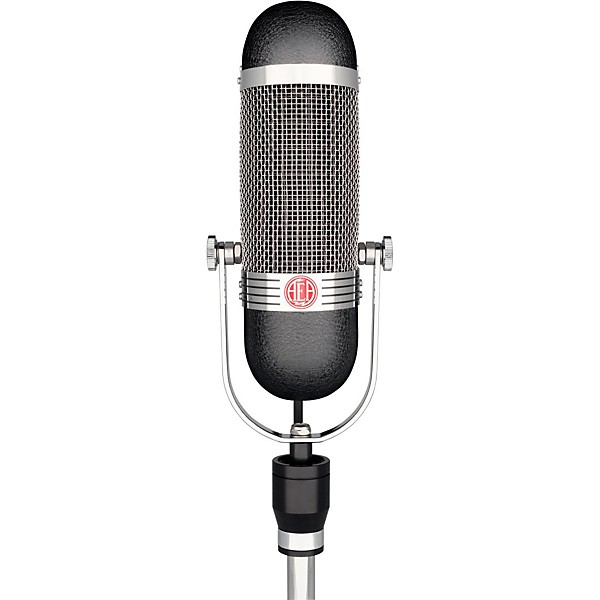Gear SpecialistBundlingMusician
Open Box
Open Box AEA Microphones R84 Bidirectional Big Ribbon Studio Microphone Level 1
(1)|Q&A|Item #:J52651004000000
Condition: Open Box - Like New
6-month special financing^ + $47 back in Rewards** Limited time Learn More
Lease-To-Own Purchase OptionsLearn more
Protect your gearLearn more
Cover drops, spills or cracks with Pro Coverage
Save on orders $199+ and get expert advice from a Gear Adviser
Need Help?
Description
The R84 was designed to be flexible and practical in a myriad of recording settings. It delivers exceptional headroom while maintaining an intimate performance quality with smooth highs and extended lows. These aspects, combined with the reduced proximity effect, make the R84 incredibly well suited for both close-up and ambient mic applications. It’s just as versatile as an R44, flattering voice, strings, brass and drums alike.
The AEA R84 uses a 2.35" by 0.185" by 2-micron pure aluminum low-tension (16.5Hz) ribbon element, just like the classic R44. Many ribbon mic manufacturers choose shorter ribbons that are easier to install, but AEA’s Large Ribbon Geometry design offers important advantages. Ribbon microphones operate linearly above their resonant frequency, unlike condenser or moving coil transducers, so the resonant frequency of a good microphone design should be as low as possible. The longer the ribbon, the lower the resonant frequency will be. The ribbon has to move twice as far for every drop in octave as it vibrates within the magnetic gap, thus, a longer ribbon will allow for further movement back and forth. This results in the ribbon handling louder sound sources and more sound pressure level.
In 1976, when General Electric bought RCA and closed down its microphone division, AEA began servicing RCA’s legendary ribbon mics. Twenty-two years later, AEA reissued the iconic 44 ribbon mic and has continued to make ribbon microphones in the RCA tradition to this day. From the R84 Workshorse, R92 Up-Close Passive, Stereo R88 and Supercardioid KU4—there is a AEA Legacy microphone for every application and setting.
The AEA R84 uses a 2.35" by 0.185" by 2-micron pure aluminum low-tension (16.5Hz) ribbon element, just like the classic R44. Many ribbon mic manufacturers choose shorter ribbons that are easier to install, but AEA’s Large Ribbon Geometry design offers important advantages. Ribbon microphones operate linearly above their resonant frequency, unlike condenser or moving coil transducers, so the resonant frequency of a good microphone design should be as low as possible. The longer the ribbon, the lower the resonant frequency will be. The ribbon has to move twice as far for every drop in octave as it vibrates within the magnetic gap, thus, a longer ribbon will allow for further movement back and forth. This results in the ribbon handling louder sound sources and more sound pressure level.
In 1976, when General Electric bought RCA and closed down its microphone division, AEA began servicing RCA’s legendary ribbon mics. Twenty-two years later, AEA reissued the iconic 44 ribbon mic and has continued to make ribbon microphones in the RCA tradition to this day. From the R84 Workshorse, R92 Up-Close Passive, Stereo R88 and Supercardioid KU4—there is a AEA Legacy microphone for every application and setting.
Features
- Same Big Ribbon, tuning and transformer as the R44 series
- Classic look, but with milder proximity effect than the R44
- Intimate performance quality with smooth highs and extended lows
- Easy to use and more affordable
- Versatile for close-up and ambient mic applications
- 100% handcrafted in Pasadena, CA
Specs
- Operating Principle: Pressure gradient transducer
- Directional Pattern: Bidirectional
- Frequency Range: <20Hz to >20kHz
- Maximum SPL: 165 + dB SPL (1% third harmonic > 1kHz)
- Sensitivity: 2.5 mV/Pa (-52 dBv/Pa) into unloaded circuit
- Output Impedance: 270 ohm nominal
- Recommended Load Impedance: 1.2 kohm or greater
- Phantom Power: Not required or recommended
- Polarity: Pin 2 high for positive pressure on front of microphone.
- Polar Response: Native bidirectional, figure-of-8 pattern
- Horizontal: Up to 90dB rejection at right angles to the front/back axis.
- Vertical: Level changes with angle of incidence, frequency response is consistent.
- Transducer Element Material: Pure aluminum corrugated ribbon
- Thickness: 1.8 μm
- Width: 0.185"
- Length: 2.35"Microphone Dimensions Height: 11.6"
- Width: 3.9"
- Depth: 2.5"
- Weight with cable: 3 lb.
- Connector: XLR-3M







